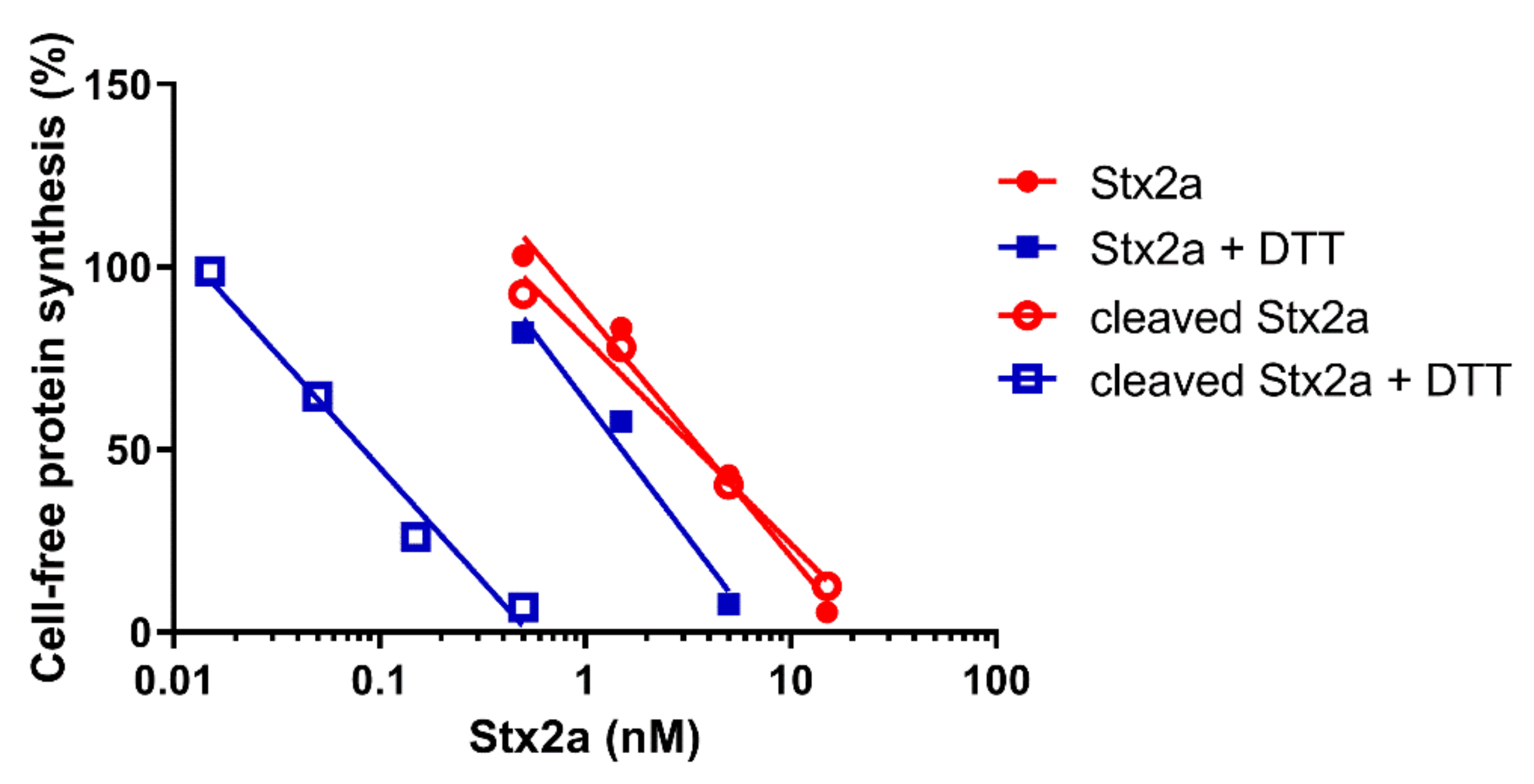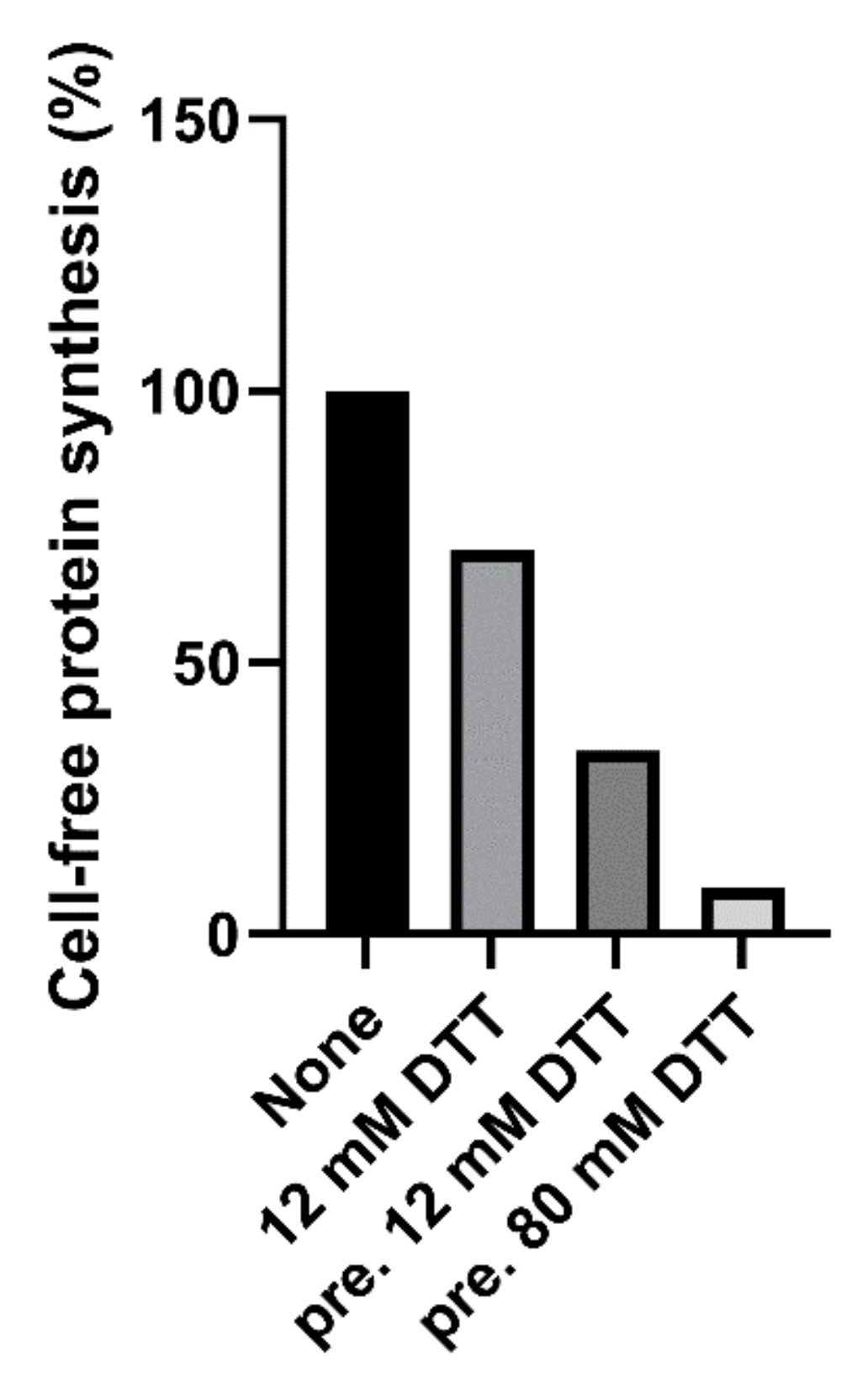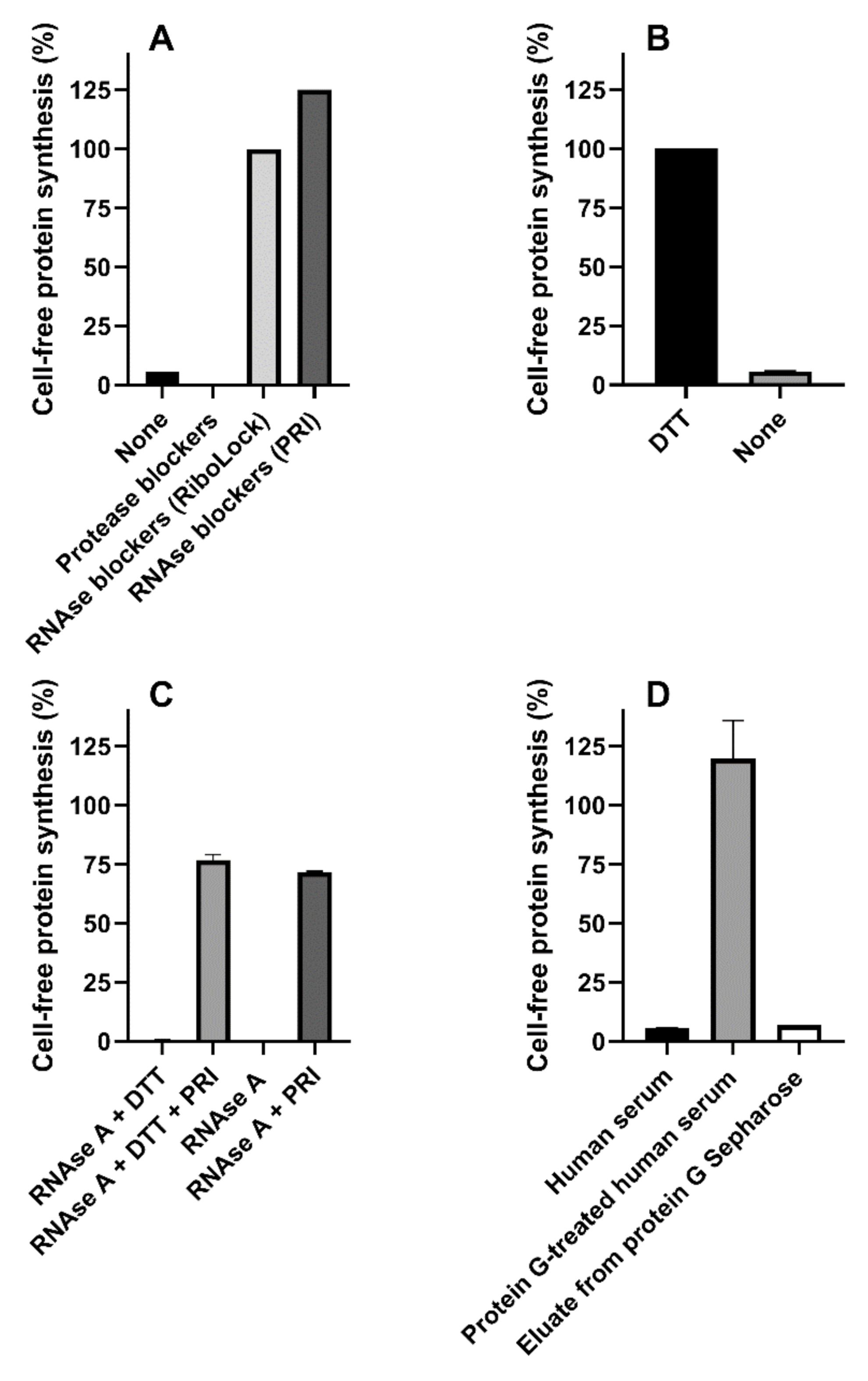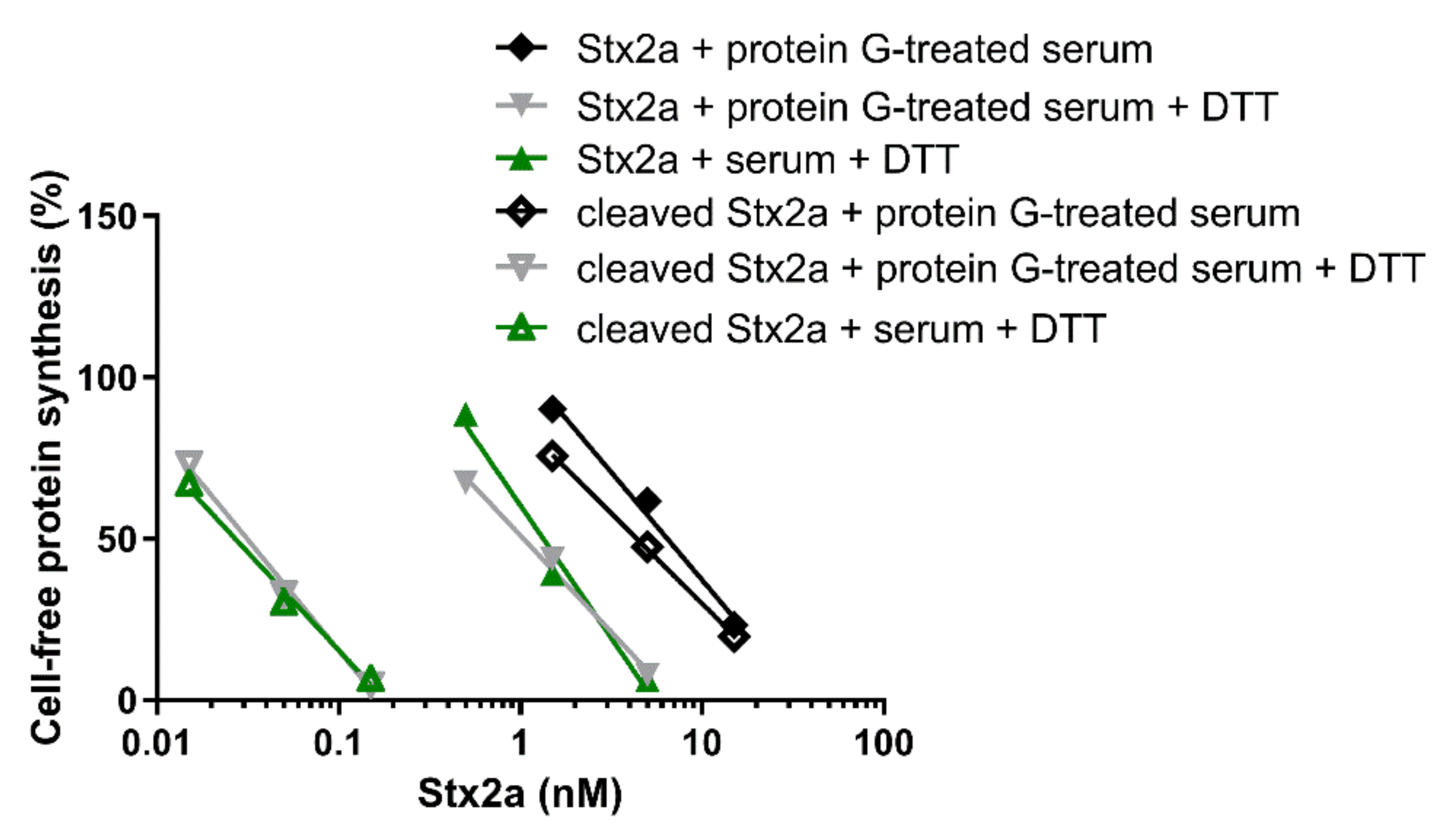Method for the Detection of the Cleaved Form of Shiga Toxin 2a Added to Normal Human Serum
Abstract
:1. Introduction
2. Results
2.1. Choice of the Cell-Free Translation System
2.2. Choice of Reducing Conditions that Boost the Activity of Cleaved Stx2a in the Cell-Free Translation System
2.3. Determination of the Cleaved Form in Samples of Purified Stx2a
Scheme I: Determination of the Percentage of Cleaved Stx2a after Toxin Purification
- Determine the IC50 of your Stx2a sample by the cell-free translation system described in the paper, in the presence and in the absence of DTT
- Calculate the fold decrease of your sample:
- Refer to the following fold decreases calculated from the IC50 values in Table 1:
- If the fold decrease calculated with your sample is ≤2.4 A1 = 0%
- If the fold decrease calculated with your sample is >2.4 and <41.9 use the following Equation
- If the fold decrease calculated with your sample is ≥41.9 A1 = 100%
2.4. Blocking Naturally Occurring Inhibitors of Cell-Free Protein Synthesis Present in Human Serum
2.5. Detection of the Cleaved Form of Stx2a Added to Human Serum by the Cell-Free Translation System
2.6. Lowering the Detection Limit of the Cell-Free Translation System for Cleaved Stx2a Added to Human Serum
Scheme II: Detection of the Cleaved Form of Stx2a in Human Sera from STEC-Infected Patients
- Determine the concentration of Stx2 (ng/mL) present in human sera by ELISA [17] referring to a standard curve obtained by adding purified Stx2a to normal human serum at 2, 4, 6, 8 and 10 ng/mL and incubating 10 min at 37 °C. Serum samples (60 μL) for Stx2 detection for the standard curve should be treated with an equal volume of 0.4 M guanidinium chloride for 1 h at 37 °C, then 100 μL of the mixture should be assayed by using a commercially available kit (cat. n. 542010 Eurofins Abraxis, Warminster, PA, USA). The antibodies purchased in the kit recognize both the native and the cleaved form of the toxin.
- Refer to the following ranges of detectable Stx2a serum concentrations calculated from the equations of the straight lines obtained by the experiments described in the paper and reported in Supplementary Materials Table S1:
- Determine the effect on protein synthesis of the protein G-treated patient’s serum sample with respect to a pool of protein G-treated sera from healthy donors (at least 3) by the cell-free translation system described in the paper in the presence and in the absence of DTT.
- Calculate the percentage activity in each condition = %Act
- Use the b (y-intercept) and m (slope) of the appropriate straight line reported in Supplementary Materials Table S1 of the paper to calculate the serum concentration of the specific toxin form according to the following equation:
- Confirm the absence of inhibition by determining the effect on protein synthesis of the protein G-treated patient’s serum sample with respect to a pool of protein G-treated sera from healthy donors (at least 3) by the cell-free translation system described in the paper in the presence and in the absence of DTT.
- If no inhibitions are detectable, concentrate the protein G-treated patient’s serum sample by 5-fold as described in the paper.
- Determine the effect on protein synthesis of the 5-fold concentrate protein G-treated patient’s serum sample with respect to a 5-fold concentrated pool of protein G-treated sera from healthy donors (at least 3) by the cell-free translation system described in the paper only in the presence of DTT.
- Calculate the percentage activity = %Act
- Use the b (y-intercept = −53) and m (slope = −68.49) of the straight line obtained with cleaved Stx2a + protein G-treated serum + DTT (Supplementary Materials Table S1) to calculate the serum concentration of cleaved Stx2a
3. Discussion
4. Materials and Methods
4.1. Materials and Toxin
4.2. Cleavage of Stx2a
4.3. Cell-Free Protein Synthesis Systems
4.4. Treatment of Human Serum with Protein G Sepharose
4.5. Statistics
Supplementary Materials
Author Contributions
Funding
Institutional Review Board Statement
Data Availability Statement
Acknowledgments
Conflicts of Interest
References
- Detzner, J.; Pohlentz, G.; Muthing, J. Valid presumption of Shiga toxin-mediated damage of developing erythrocytes in EHEC-associated hemolytic uremic syndrome. Toxins 2020, 12, 373. [Google Scholar] [CrossRef]
- Menge, C. Molecular biology of Escherichia coli Shiga toxins’ effects on mammalian cells. Toxins 2020, 12, 345. [Google Scholar] [CrossRef]
- Tarr, P.I.; Gordon, C.A.; Chandler, W.L. Shiga-toxin-producing Escherichia coli and haemolytic uraemic syndrome. Lancet 2005, 365, 1073–1086. [Google Scholar] [CrossRef]
- Brigotti, M.; He, X.; Carnicelli, D.; Arfilli, V.; Porcellini, E.; Galassi, E.; Tazzari, P.L.; Ricci, F.; Patfield, S.A.; Testa, S.; et al. Particulate Shiga toxin 2 in blood is associated to the development of hemolytic uremic syndrome in children. Thromb. Haemost. 2020, 120, 107–120. [Google Scholar] [CrossRef] [PubMed]
- Stahl, A.L.; Arvidsson, I.; Johansson, K.E.; Chromek, M.; Rebetz, J.; Loos, S.; Kristoffersson, A.C.; Bekassy, Z.D.; Morgelin, M.; Karpman, D. A novel mechanism of bacterial toxin transfer within host blood cell-derived microvesicles. PLoS Pathog. 2015, 11, e1004619. [Google Scholar] [CrossRef] [PubMed] [Green Version]
- Stahl, A.L.; Sartz, L.; Karpman, D. Complement activation on platelet-leukocyte complexes and microparticles in enterohemorrhagic Escherichia coli-induced hemolytic uremic syndrome. Blood 2011, 117, 5503–5513. [Google Scholar] [CrossRef] [Green Version]
- Stahl, A.L.; Sartz, L.; Nelsson, A.; Bekassy, Z.D.; Karpman, D. Shiga toxin and lipopolysaccharide induce platelet-leukocyte aggregates and tissue factor release, a thrombotic mechanism in hemolytic uremic syndrome. PLoS ONE 2009, 4, e6990. [Google Scholar] [CrossRef] [PubMed] [Green Version]
- Orth, D.; Khan, A.B.; Naim, A.; Grif, K.; Brockmeyer, J.; Karch, H.; Joannidis, M.; Clark, S.J.; Day, A.J.; Fidanzi, S.; et al. Shiga toxin activates complement and binds factor H: Evidence for an active role of complement in hemolytic uremic syndrome. J. Immunol. 2009, 182, 6394–6400. [Google Scholar] [CrossRef] [PubMed] [Green Version]
- Poolpol, K.; Orth-Holler, D.; Speth, C.; Zipfel, P.F.; Skerka, C.; de Cordoba, S.R.; Brockmeyer, J.; Bielaszewska, M.; Wurzner, R. Interaction of Shiga toxin 2 with complement regulators of the factor H protein family. Mol. Immunol. 2014, 58, 77–84. [Google Scholar] [CrossRef]
- Garred, O.; van Deurs, B.; Sandvig, K. Furin-induced cleavage and activation of Shiga toxin. J. Biol. Chem. 1995, 270, 10817–10821. [Google Scholar] [CrossRef] [PubMed] [Green Version]
- Garred, O.; Dubinina, E.; Polesskaya, A.; Olsnes, S.; Kozlov, J.; Sandvig, K. Role of the disulfide bond in Shiga toxin A-chain for toxin entry into cells. J. Biol. Chem. 1997, 272, 11414–11419. [Google Scholar] [CrossRef] [PubMed] [Green Version]
- Brigotti, M.; Orth-Holler, D.; Carnicelli, D.; Porcellini, E.; Galassi, E.; Tazzari, P.L.; Ricci, F.; Manoli, F.; Manet, I.; Talasz, H.; et al. The structure of the Shiga toxin 2a A-subunit dictates the interactions of the toxin with blood components. Cell. Microbiol. 2019, 21, e13000. [Google Scholar] [CrossRef] [PubMed] [Green Version]
- Melton-Celsa, A.R.; Darnell, S.C.; O’Brien, A.D. Activation of Shiga-like toxins by mouse and human intestinal mucus correlates with virulence of enterohemorrhagic Escherichia coli O91:H21 isolates in orally infected, streptomycin-treated mice. Infect. Immun. 1996, 64, 1569–1576. [Google Scholar] [CrossRef] [Green Version]
- Brown, J.E.; Ussery, M.A.; Leppla, S.H.; Rothman, S.W. Inhibition of protein synthesis by Shiga toxin: Activation of the toxin and inhibition of peptide elongation. FEBS Lett. 1980, 117, 84–88. [Google Scholar] [CrossRef] [Green Version]
- Penzo, M.; Carnicelli, D.; Montanaro, L.; Brigotti, M. A reconstituted cell-free assay for the evaluation of the intrinsic activity of purified human ribosomes. Nat. Protoc. 2016, 11, 1309–1325. [Google Scholar] [CrossRef]
- Donohue-Rolfe, A.; Jacewicz, M.; Keusch, G.T. Shiga toxin as inhibitor of protein synthesis. Methods Enzymol. 1988, 165, 231–235. [Google Scholar]
- He, X.; Ardissino, G.; Patfield, S.; Cheng, L.W.; Silva, C.J.; Brigotti, M. An improved method for the sensitive detection of Shiga toxin 2 in human serum. Toxins 2018, 10, 59. [Google Scholar] [CrossRef] [Green Version]
- Lopez, E.L.; Contrini, M.M.; Glatstein, E.; Gonzalez Ayala, S.; Santoro, R.; Ezcurra, G.; Teplitz, E.; Matsumoto, Y.; Sato, H.; Sakai, K.; et al. An epidemiologic surveillance of Shiga-like toxin-producing Escherichia coli infection in argentinean children: Risk factors and serum Shiga-like toxin 2 values. Pediatr. Infect. Dis. J. 2012, 31, 20–24. [Google Scholar] [CrossRef]
- Brigotti, M.; Carnicelli, D.; Arfilli, V.; Tamassia, N.; Borsetti, F.; Fabbri, E.; Tazzari, P.L.; Ricci, F.; Pagliaro, P.; Spisni, E.; et al. Identification of TLR4 as the receptor that recognizes Shiga toxins in human neutrophils. J. Immunol. 2013, 191, 4748–4758. [Google Scholar] [CrossRef] [Green Version]
- Matussek, A.; Lauber, J.; Bergau, A.; Hansen, W.; Rohde, M.; Dittmar, K.E.; Gunzer, M.; Mengel, M.; Gatzlaff, P.; Hartmann, M.; et al. Molecular and functional analysis of Shiga toxin-induced response patterns in human vascular endothelial cells. Blood 2003, 102, 1323–1332. [Google Scholar] [CrossRef]
- Arfilli, V.; Carnicelli, D.; Ardissino, G.; Torresani, E.; Scavia, G.; Brigotti, M. A rapid and sensitive method to measure the functional activity of Shiga toxins in human serum. Toxins 2015, 7, 4564–4576. [Google Scholar] [CrossRef] [PubMed]






| Additions | IC50 (nM) |
|---|---|
| Stx2a | 3.680 |
| Stx2a + DTT | 1.511 |
| cleaved Stx2a | 3.475 |
| cleaved Stx2a + DTT | 0.083 |
| Additions | IC50 (nM) |
|---|---|
| Stx2a + protein G-treated serum | 6.449 |
| Stx2a + protein G-treated serum + DTT | 1.042 |
| Stx2a + serum + DTT | 1.339 |
| cleaved Stx2a + protein G-treated serum | 4.389 |
| cleaved Stx2a + protein G-treated serum + DTT | 0.031 |
| cleaved Stx2a + serum + DTT | 0.027 |
Publisher’s Note: MDPI stays neutral with regard to jurisdictional claims in published maps and institutional affiliations. |
© 2021 by the authors. Licensee MDPI, Basel, Switzerland. This article is an open access article distributed under the terms and conditions of the Creative Commons Attribution (CC BY) license (http://creativecommons.org/licenses/by/4.0/).
Share and Cite
Rocchetti, L.; Munari, B.; Varrone, E.; Porcellini, E.; Orth-Höller, D.; Würzner, R.; Carnicelli, D.; Brigotti, M. Method for the Detection of the Cleaved Form of Shiga Toxin 2a Added to Normal Human Serum. Toxins 2021, 13, 94. https://doi.org/10.3390/toxins13020094
Rocchetti L, Munari B, Varrone E, Porcellini E, Orth-Höller D, Würzner R, Carnicelli D, Brigotti M. Method for the Detection of the Cleaved Form of Shiga Toxin 2a Added to Normal Human Serum. Toxins. 2021; 13(2):94. https://doi.org/10.3390/toxins13020094
Chicago/Turabian StyleRocchetti, Lucrezia, Beatrice Munari, Elisa Varrone, Elisa Porcellini, Dorothea Orth-Höller, Reinhard Würzner, Domenica Carnicelli, and Maurizio Brigotti. 2021. "Method for the Detection of the Cleaved Form of Shiga Toxin 2a Added to Normal Human Serum" Toxins 13, no. 2: 94. https://doi.org/10.3390/toxins13020094





